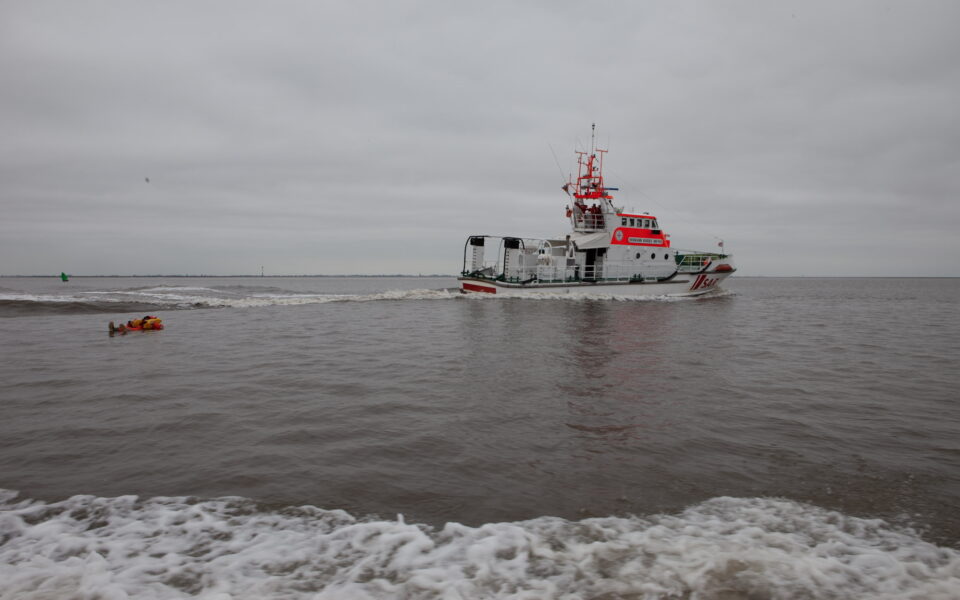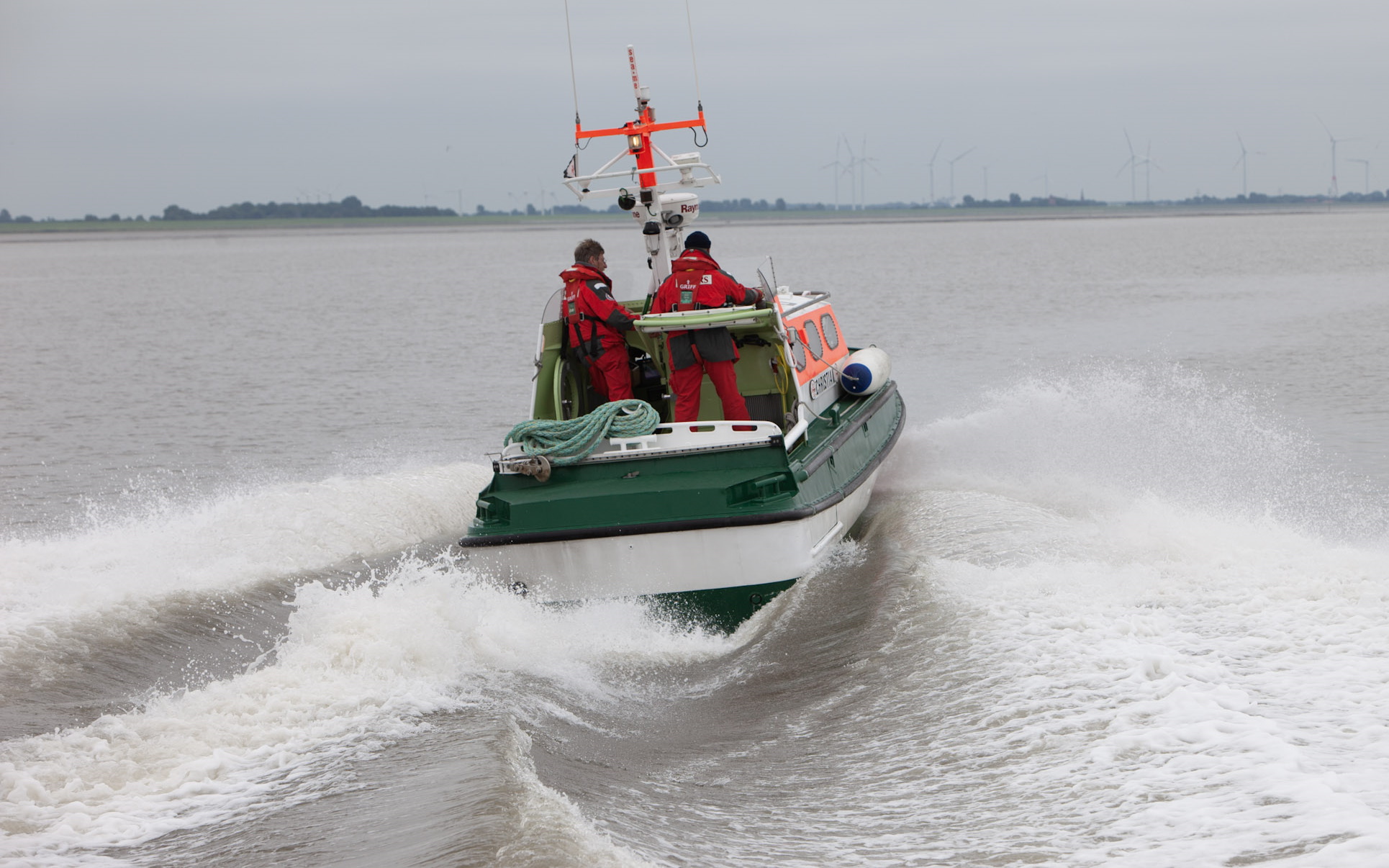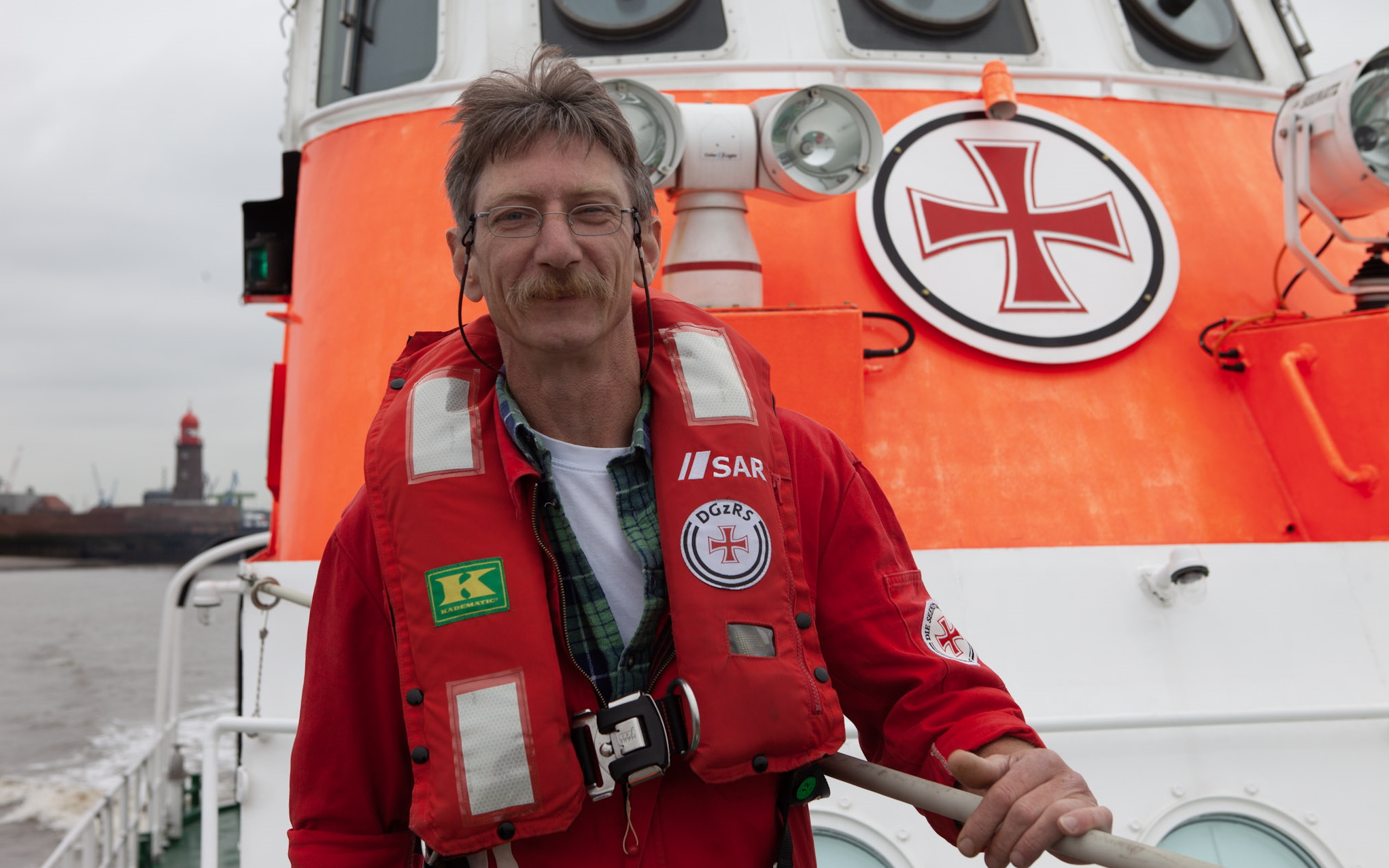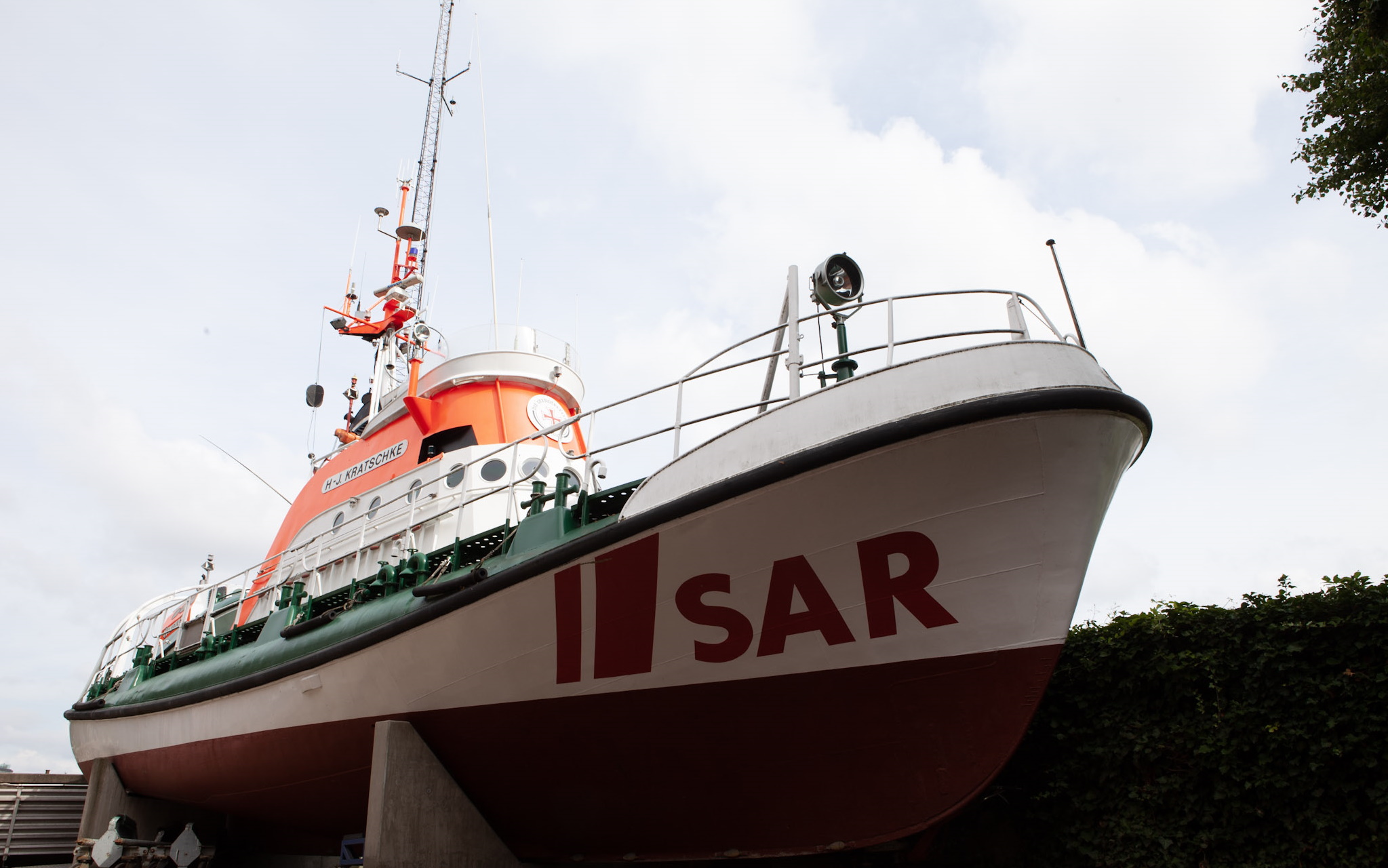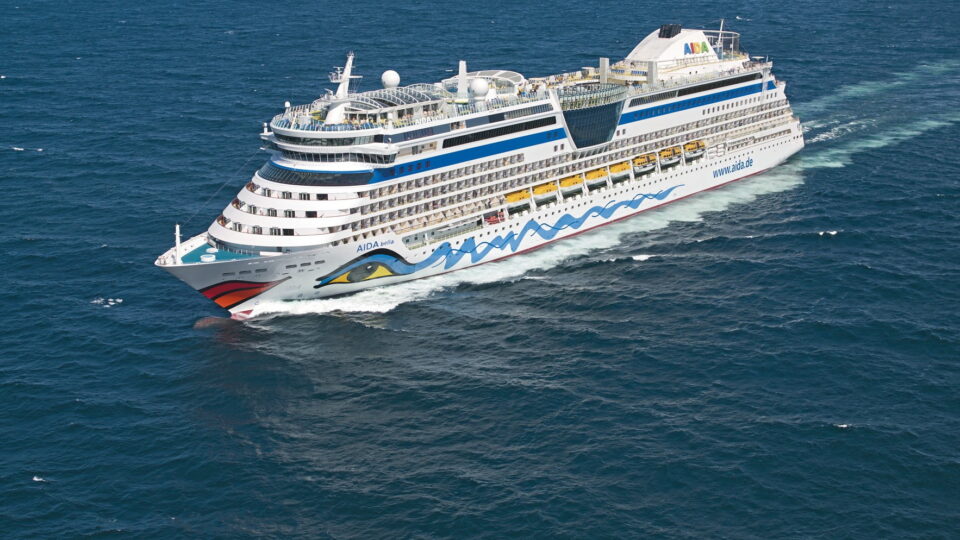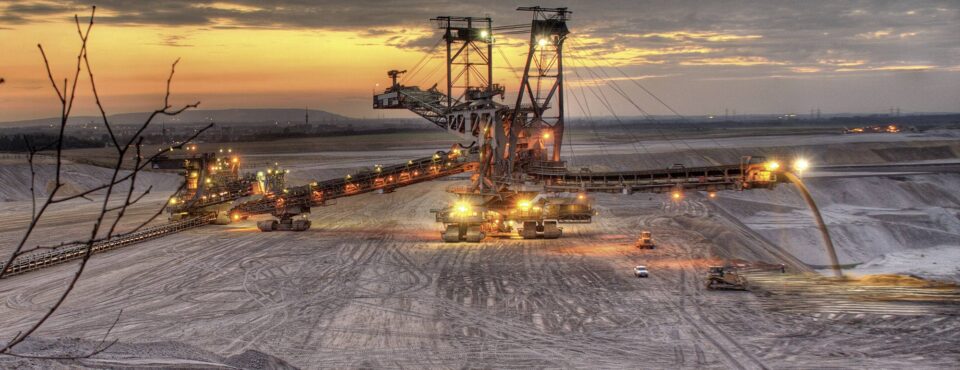The men and women of the German Maritime Search and Rescue Service (DGzRS) experience emergencies a good 2,000 times a year. They go out to sea to help people in distress. Day and night, wind and weather, summer and winter.
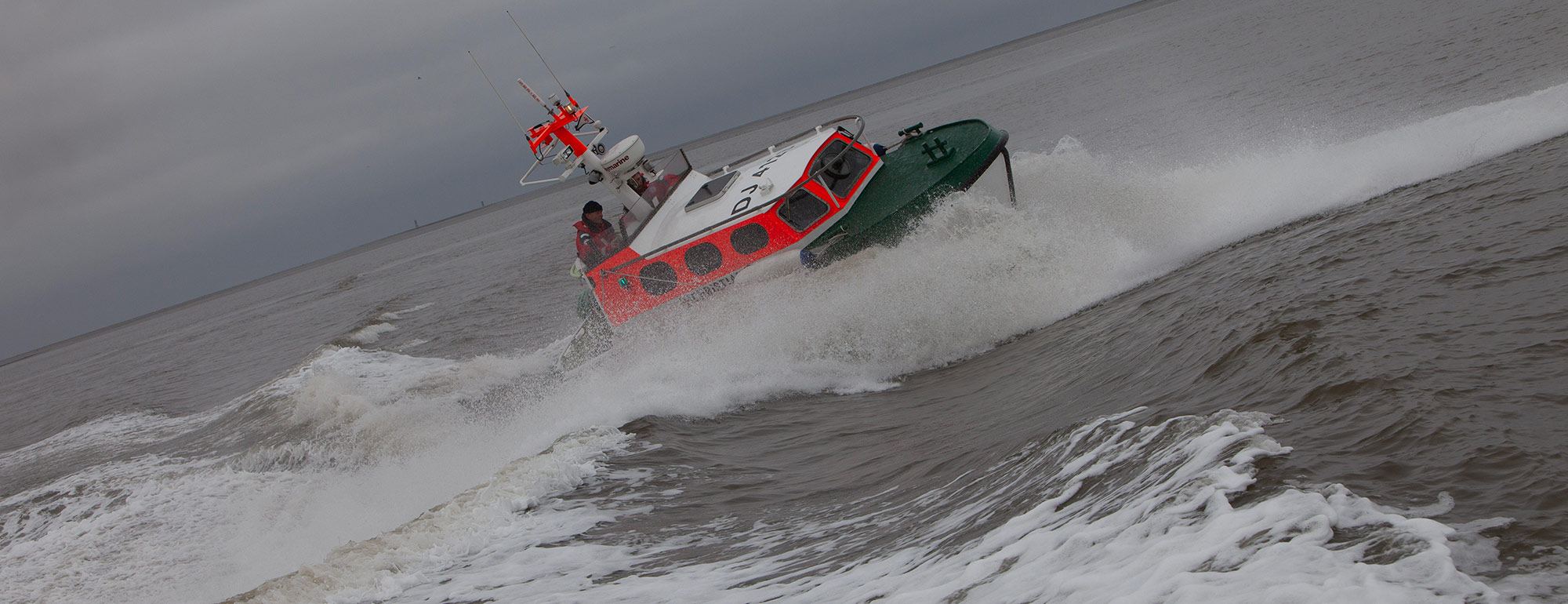
12.03.2024
They launch whatever the weather
The men and women of the German Maritime Search and Rescue Service (DGzRS) experience emergencies a good 2,000 times a year. They go out to sea to help people in distress. Day and night, wind and weather, summer and winter.
After a moment of slight hesitation, I screw up my courage and jump over the side. It feels like a millisecond later, and the vastness of the North Sea closes over me. My survival suit brings me back to the surface, but a short period of complete submersion is unavoidable. As soon as I surface, I spit water out and pull on a tab. My lifejacket inflates itself, filling my field of vision almost entirely. Any attempt at orientation seems hopeless. All I can see is water. It’s quiet out here. Eerily quiet. I hadn’t expected that. Fortunately, my suit keeps me warm. Otherwise, with a temperature of 16 degrees the water would slowly but surely suck all of the warmth out of my body. I bob helplessly in the North Sea for several minutes. If I did not know that a lifeboat has to be somewhere very close by, I would be panicking now. Even so, the minutes drag by fearfully slowly, and gradually I begin to have my doubts. Why can’t I hear the engines? Was it really a good idea to volunteer as a live test subject? Why, exactly, did I ask for this assignment? Am I sure there are no sharks in the North Sea? Little by little, I am overcome by uneasiness. Then I become aware of voices. A short time later, the sound of engines. Gradually, my pulse rate slows. I am not alone out here. Rescue is approaching. A good feeling. When the daughter boat Christian of the rescue cruiser Hermann Rudolf Meyer comes alongside, a hand takes firm hold of my collar and hauls me aboard.
Rescue service at sea
Though it may have sounded dramatic in the telling, this exercise involved no danger at any time. There was practically no wind, the sea was calm, my survival suit kept me warm, and the lifeboat crew were watching when I jumped overboard. Everything had been agreed. A real emergency is completely different. And the men and women of the Deutsche Gesellschaft zur Rettung Schiffbrüchiger (DGzRS), the German Maritime Search and Rescue Service, go through it well over 2,000 times a year. Every time it happens, they head out to sea to help people in serious trouble. Day or night, in the wind and rain, summer or winter.
Because the DGzRS is the lifeboat service for the North and Baltic Seas around the German coastline. In order to provide the best possible coverage for this enormous area, a total of 61 lifeboats and rescue cruisers are permanently ready to launch from 54 stations on the islands and along the coast. And these sorties are rarely routine. The tiny body of just 186 full-time employees and over 800 volunteers in the maritime rescue service can be called on to do just about anything. Besides saving human lives at sea and administering primary medical care, the lifeboat crews tow disabled ships into the nearest safe harbour, they put out fires, they transport sick or injured individuals to safety. In short: They respond to every conceivable emergency at sea.
150 years of organised maritime rescue service
It wasn’t always like this. As late as the 19th century, emergencies at sea were considered in many places to be an immutable destiny, ordained in some way by the Almighty, and from which escape was rare. According to some estimates, by around 1850 more than 50 ships a year were still getting into difficulties off the German islands in the North Sea. Almost all of them sank, because in those days there were neither properly equipped rescue boats nor an organisation that would be able to coordinate attempts to help. This changed in 1861, when the first German regional association for rescuing victims of shipwreck was founded in Emden. The first lifeboat stations were built on the islands of Langeoog and Juist. Associations sprang up in Hamburg and Bremerhaven that same year.
With the foundation of the DGzRS on 29 March 1865 in Kiel, a unified maritime rescue service was born. The organisation is headquartered in Bremen. In the early years, fearless men would make their way to the scene of the emergency in rowing boats. On board, complete command resided with the coxswain, who set the rowing rhythm and steered the boat. The first motorised boats went into service in 1911. The technology may have changed somewhat, but the terminology remains the same: Still today, the captain of a rescue cruiser is called the coxswain. Otherwise, the rescue boats in use today have very little in common with their predecessors. They are up to 46 metres long, made entirely from aluminium to keep weight to a minimum and – as in the case of the 23 metre long Hermann Rudolf Meyer – their engines can develop more than 3,000 horsepower. On the water, they can reach speeds of 25 knots. That’s almost 50 kilometres per hour. Modern radar equipment is used to show what is moving on the water, and where, and among other tasks the hydraulic systems open the gate in the stern so that the daughter boat can be lowered into the water if it is being carried by the cruiser. The entire operation is funded entirely by donations, not from taxes or some other institutional source.
HANSA‑FLEX is also on board
Of course, this is one fleet that must be maintained constantly. For this purpose, the DGzRS operates its own repair dock at its headquarters in Bremen. Here, the rescue cruisers undergo a general overhaul at regular intervals. The hose lines, pipes and other components for the onboard hydraulic systems have been supplied by the HANSA‑FLEX branch at Arsten for many years.
A life aboard
The Hermann Rudolf Meyer, the boat we used for the bold exercise described above, belongs to the 23.1-metre class of the DGzRS. The nine-man crew works a sort of shift system. Four men live on board for 14 days and then have 14 days ashore. During the duty period, these four barely leave the boat, so that they can be sure to launch as quickly as possible. But this also means that they see each other almost every waking hour, every day. So it is crucially important that they can get on with each other. “There is absolutely no chance of avoiding someone”, explains senior coxswain Ulrich Fader. The ship has four cabins and a common room, which doubles as the ship’s hospital in an emergency. That is not much room. All new crew members must undergo a probationary period. It takes a while before the crew gets to know the newcomer and is convinced that he can be relied on totally when the chips are down. This blind reliance is everything during an operation. Because the men and women of the DGzRS risk their own lives routinely, when they have to launch in heavy seas in order to transport someone who has been injured on a ferry, for example. But all the equipment in the world does not change the fundamental fact: the sea is a realm that cannot be tamed or controlled. But experience can help. And the lifeboat crews, with their 150-year history have any amount of that.
There is so much more that could be written about the DGzRS, but unfortunately the space for this article is finite. But anyone who takes the time to find out more about the maritime rescue service quickly realises that they do one of the most important jobs in the world. You only have to read a response report to know: Heroes are not born on television game shows or live singing contests. Real heroes risk their lives every day to save others. In all weathers, at all times of the year, unceasingly. Like the men and women on the rescue cruisers of the DGzRS. They themselves don’t look at it that way at all. Coxswain Ulrich Fader would probably say: “For Pete’s sake. We’re just doing our job.” HANSA‑FLEX replies: “Thank you!”
Help out! As a thank you for 150 years of tireless service and more than 77,000 lives saved, HANSA‑FLEX is placing the well-known DGzRS collection boats in its coastal branches. One hundred per cent of the donated contents of the boats goes to the DGzRS.
Learn more
- 12.03.2024
Kissing the waves
There is a hustle and bustle at the Cruise Center in Warnemünde. Families, couples and travel groups of all ages drag their suitcases behind them in anticipation and cast expectant glances at the cruise ship AIDAbella.Find out more - 12.03.2024
Masters of the soil
Hans Wübben GmbH tills and retills agricultural and forest land.Find out more









































